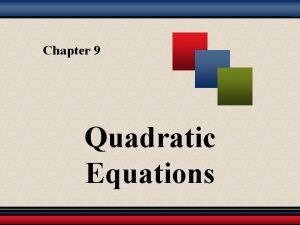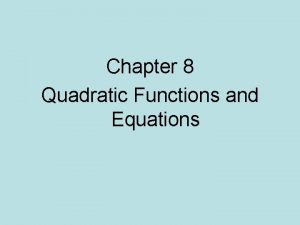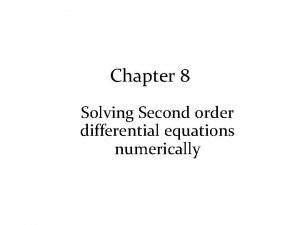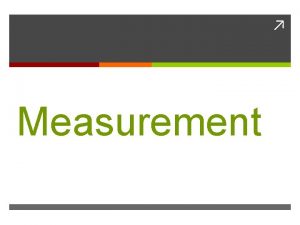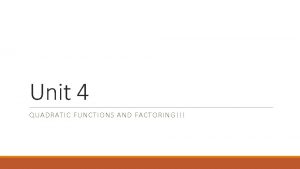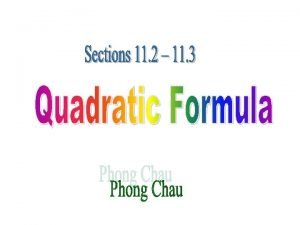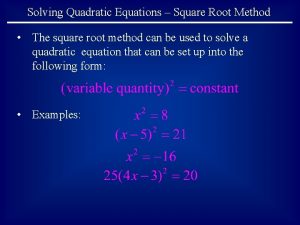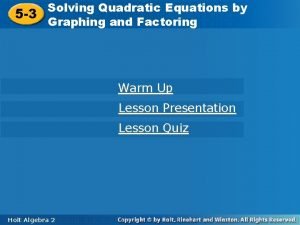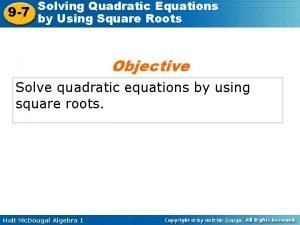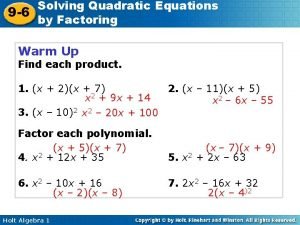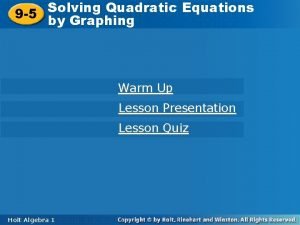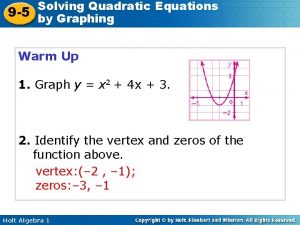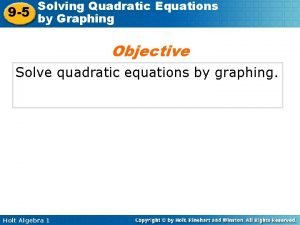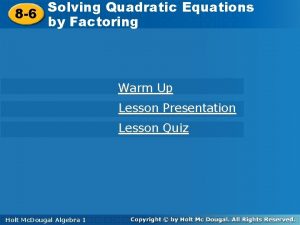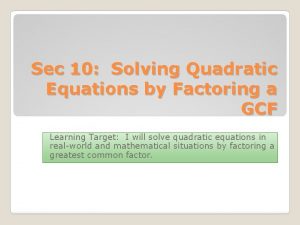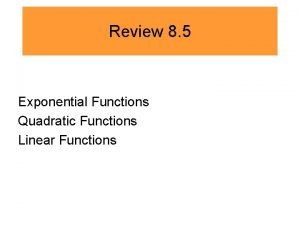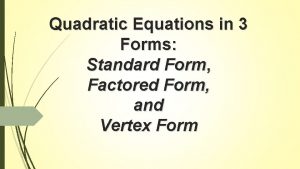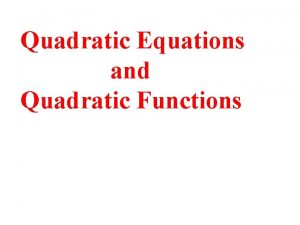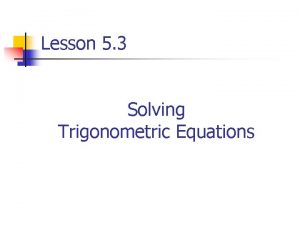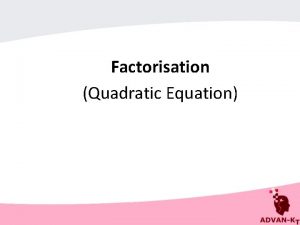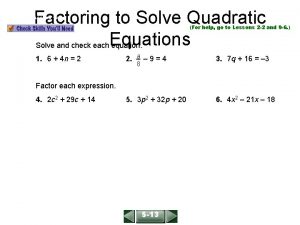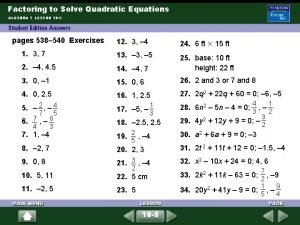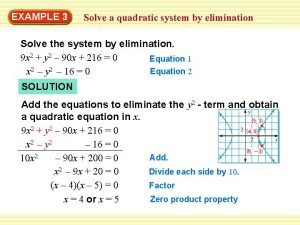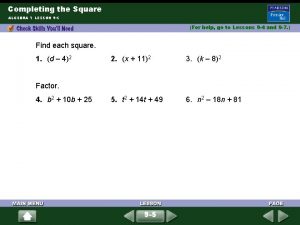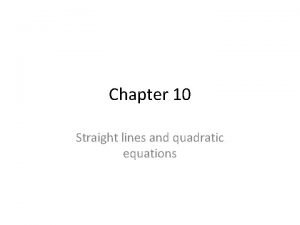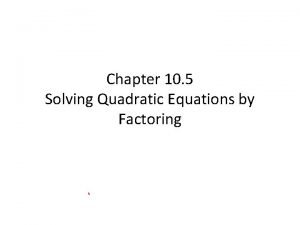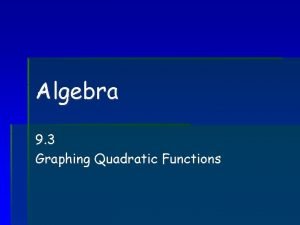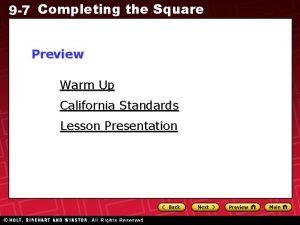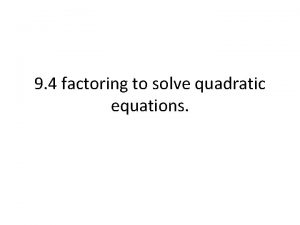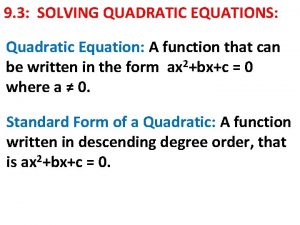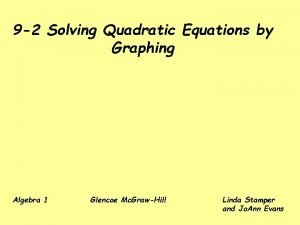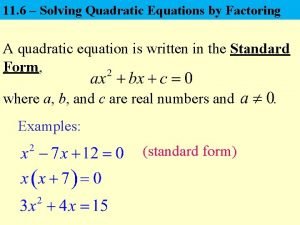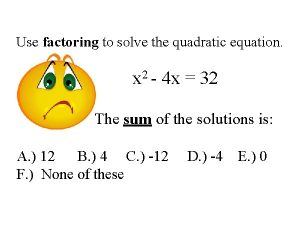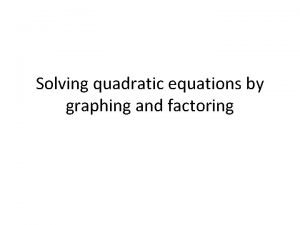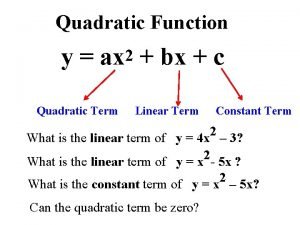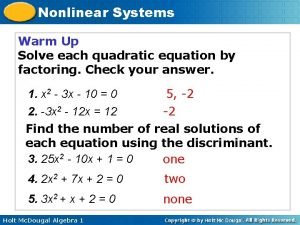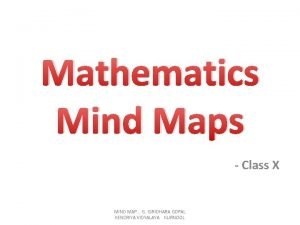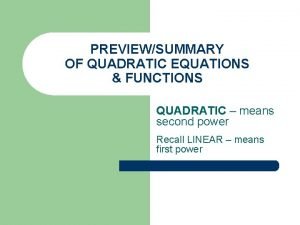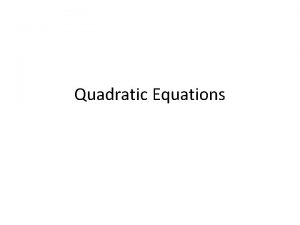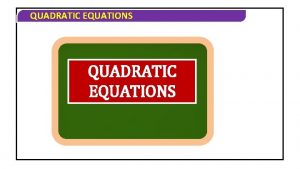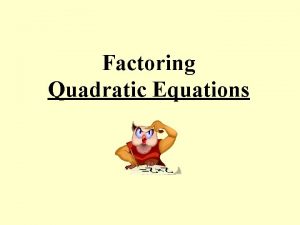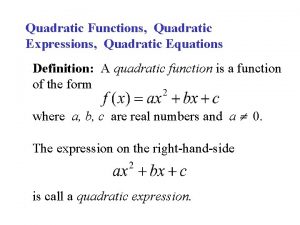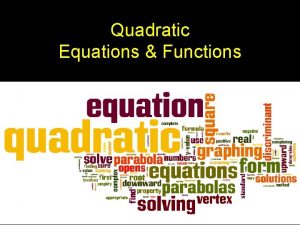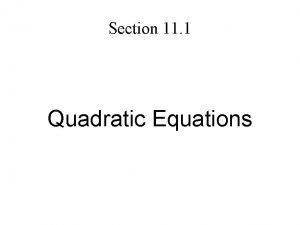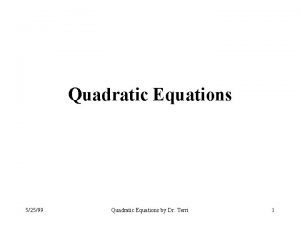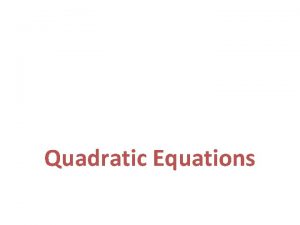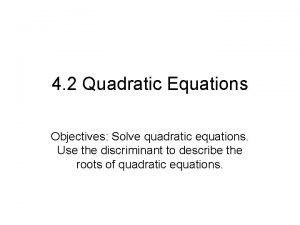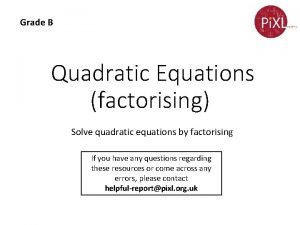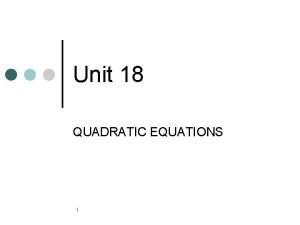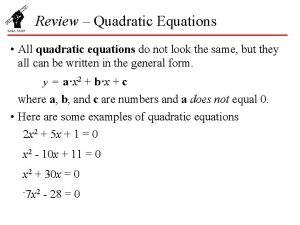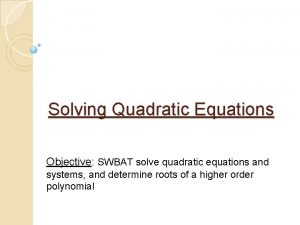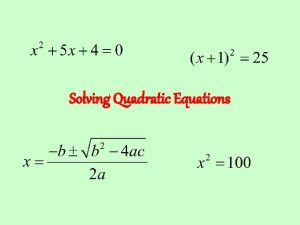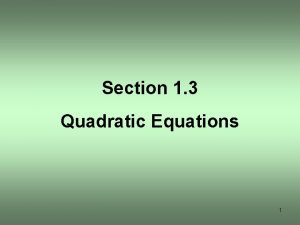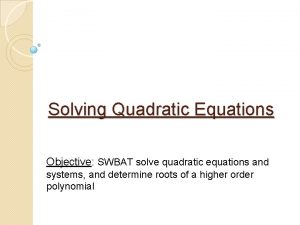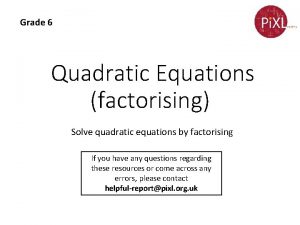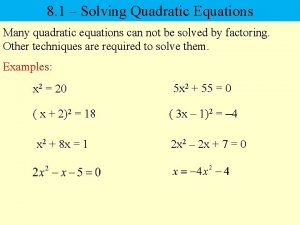PREVIEWSUMMARY OF QUADRATIC EQUATIONS FUNCTIONS QUADRATIC means second





















































- Slides: 53

PREVIEW/SUMMARY OF QUADRATIC EQUATIONS & FUNCTIONS QUADRATIC – means second power Recall LINEAR – means first power

Click on the Quadratic Method you wish to review to go to those slides Factoring Method – Quick, but only works for some quadratic problems Square Roots of Both Sides – Easy, but only works when you can get in the form of (glob)2 = constant Complete the Square– Always works, but is recommended only when a = 1 or all terms are evenly divisible to set a to 1. Quadratic Formula – Always works, but be sure to rewrite in standard form first of ax 2 + bx + c = 0 How to Choose Among Methods 1 – 4? Summary & Hints Quadratic Functions – Summary of graphing parabolas from f(x) = ax 2 + bx + c form

METHOD 1 - FACTORING l l l Set equal to zero Factor Use the Zero Product Property to solve (Each factor with a variable in it could be equal to zero. )

METHOD 1 - FACTORING Any # of terms – Look for GCF factoring first! 1. 5 x 2 = 15 x 5 x 2 – 15 x = 0 5 x (x – 3) = 0 5 x = 0 OR x – 3 = 0 x = 0 OR x = 3 {0, 3}

METHOD 1 - FACTORING Binomials – Look for Difference of Squares 2. x 2 = 9 x 2 – 9 = 0 Conjugates (x + 3) (x – 3) = 0 x + 3 = 0 OR x – 3 = 0 x = – 3 OR x = 3 {– 3, 3}

METHOD 1 - FACTORING Trinomials – Look for PST (Perfect Square Trinomial) 3. x 2 – 8 x = – 16 x 2 – 8 x + 16 = 0 (x – 4) = 0 x – 4 = 0 OR x – 4 = 0 x = 4 OR x = 4 {4 d. r. } Double Root

METHOD 1 - FACTORING Trinomials – Look for Reverse of Foil 4. 2 x 3 – 15 x = 7 x 2 2 x 3 – 7 x 2 – 15 x = 0 (x) (2 x 2 – 7 x – 15) = 0 {-3/2, 0, 5} (x) (2 x + 3)(x – 5) = 0 x = 0 OR 2 x + 3 = 0 OR x – 5 = 0 x = 0 OR x = – 3/2 OR x = 5

PREVIEW/SUMMARY OF QUADRATIC EQUATIONS & FUNCTIONS END OF METHOD 1: FACTORING Click here to return to menu slide

METHOD 2 – SQUARE ROOTS OF BOTH SIDES l l l Reorder terms IF needed Works whenever form is (glob)2 = c Take square roots of both sides (Remember you will need a l l sign!) Simplify the square root if needed Solve for x. (Isolate it. )

METHOD 2 – SQUARE ROOTS OF BOTH SIDES 1. x 2 = 9 x= 3 {-3, 3} Note means both +3 and -3! x = -3 OR x = 3

METHOD 2 – SQUARE ROOTS OF BOTH SIDES 2. x 2 = 18

METHOD 2 – SQUARE ROOTS OF BOTH SIDES 3. x 2 = – 9 Cannot take a square root of a negative. There are NO real number solutions!

METHOD 2 – SQUARE ROOTS OF BOTH SIDES 4. (x-2)2 = 9 {-1, 5} This means: x = 2 + 3 and x = 2 – 3 x = 5 and x = – 1

METHOD 2 – SQUARE ROOTS OF BOTH SIDES Rewrite as (glob)2 = c first if necessary. 5. x 2 – 10 x + 25 = 9 (x – 5)2 = 9 x = 8 and x = 2 {2, 8}

METHOD 2 – SQUARE ROOTS OF BOTH SIDES Rewrite as (glob)2 = c first if necessary. 6. x 2 – 10 x + 25 = 48 (x – 5)2 = 48

PRACTICE METHOD 2 – SQUARE ROOTS OF BOTH SIDES 1. x 2 = 121 x = 11 {-11, 11} Note means both +11 and -11! x = -11 OR x = 11

PRACTICE METHOD 2 – SQUARE ROOTS OF BOTH SIDES 2. 2 x = – 81 Square root of a negative, so there are NO real number solutions!

PRACTICE METHOD 2 – SQUARE ROOTS OF BOTH SIDES Rewrite as (glob)2 = c first if necessary. 3. 6 x 2 = 156 x 2 = 26

PRACTICE METHOD 2 – SQUARE ROOTS OF BOTH SIDES 4. (a – 7)2 = 3

PRACTICE METHOD 2 – SQUARE ROOTS OF BOTH SIDES Rewrite as (glob)2 = c first if necessary. 5. 9(x 2 – 14 x + 49) = 4 (x – 7)2 = 4/9 {6⅓, 7⅔}

PRACTICE METHOD 2 – SQUARE ROOTS OF BOTH SIDES 6.

PREVIEW/SUMMARY OF QUADRATIC EQUATIONS & FUNCTIONS END OF METHOD 2: SQUARE ROOTS OF BOTH SIDES Click here to return to menu slide

METHOD 3 – COMPLETE THE SQUARE • • • Goal is to get into the format: (glob)2 = c Method always works, but is only recommended when a = 1 or all the coefficients are divisible by a We will practice this method repeatedly and then it will keep getting easier!

METHOD 3 – COMPLETE THE SQUARE Example: 3 x 2 – 6 = x 2 + 12 x 2 x 2 – 12 x – 6 = 0 Simplify and write in standard form: ax 2 + bx + c = 0 x 2 – 6 x – 3 = 0 Set a = 1 by division Note: in some problems a will already be equal to 1.

METHOD 3 – COMPLETE THE SQUARE x 2 – 6 x – 3 = 0 x 2 – 6 x =3 Move constant to other side x 2 – 6 x + 9 = 3 + 9 Add (b/2)2 to both sides Leave space to replace it! This completes a PST! (x – 3)2 = 12 Rewrite as (glob)2 = c

METHOD 3 – COMPLETE THE SQUARE (x – 3)2 = 12 Take square roots of both sides – don’t forget Simplify Solve for x

PRACTICE METHOD 3 – COMPLETE THE SQUARE Example: 2 b 2 = 16 b + 6 2 b 2 – 16 b – 6 = 0 Simplify and write in standard form: ax 2 + bx + c = 0 b 2 – 8 b – 3 = 0 Set a = 1 by division Note: in some problems a will already be equal to 1.

PRACTICE METHOD 3 – COMPLETE THE SQUARE b 2 – 8 b – 3 = 0 b 2 – 8 b =3 b 2 – 8 b + 16 = 3 +16 Move constant to other side Leave space to replace it! Add (b/2)2 to both sides This completes a PST! (b – 4)2 = 19 Rewrite as (glob)2 = c

PRACTICE METHOD 3 – COMPLETE THE SQUARE (b – 4)2 = 19 Take square roots of both sides – don’t forget Simplify Solve for the variable

PRACTICE METHOD 3 – COMPLETE THE SQUARE Example: 3 n 2 + 19 n + 1 = n - 2 3 n 2 + 18 n + 3 = 0 Simplify and write in standard form: ax 2 + bx + c = 0 n 2 + 6 n + 1 = 0 Set a = 1 by division Note: in some problems a will already be equal to 1.

PRACTICE METHOD 3 – COMPLETE THE SQUARE n 2 + 6 n + 1 = 0 n 2 + 6 n = -1 Move constant to other side Leave space to replace it! n 2 + 6 n + 9 = -1 + 9 Add (b/2)2 to both sides This completes a PST! (n + 3)2 =8 Rewrite as (glob)2 = c

PRACTICE METHOD 3 – COMPLETE THE SQUARE (n + 3)2 = 8 Take square roots of both sides – don’t forget Simplify Solve for the variable

PRACTICE METHOD 3 – COMPLETE THE SQUARE What number “completes each square”? 1. x 2 – 10 x = -3 1. x 2 – 10 x + 25 = -3 + 25 2. x 2 + 14 x =1 2. x 2 + 14 x + 49 = 1 + 49 3. x 2 – 1 x =5 3. x 2 – 1 x + ¼ = 5 + ¼ 4. 2 x 2 – 40 x =4 4. x 2 – 20 x + 100 = 2 + 100

PRACTICE METHOD 3 – COMPLETE THE SQUARE Now rewrite as (glob)2 = c 1. x 2 – 10 x + 25 = -3 + 25 1. (x – 5)2 = 22 2. x 2 + 14 x + 49 = 1 + 49 2. (x + 7)2 = 50 3. x 2 – 1 x + ¼ = 5 + ¼ 3. (x – ½ )2 = 5 ¼ 4. x 2 – 20 x + 100 = 2 + 100 4. (x – 10)2 = 102

PRACTICE METHOD 3 – COMPLETE THE SQUARE Show all steps to solve. 2 ⅓k = 4 k k 2 = 12 k 2 k -⅔ -2 - 12 k =-2 k 2 - 12 k + 36 = - 2 + 36 (k - 6)2 = 34

PREVIEW/SUMMARY OF QUADRATIC EQUATIONS & FUNCTIONS END OF METHOD 3: COMPLETE THE SQUARE Click here to return to menu slide

METHOD 4 – QUADRATIC FORMULA • This is a formula you will need to memorize! Works to solve all quadratic equations Rewrite in standard form in order to identify the values of a, b and c. Plug a, b & c into the formula and simplify! • QUADRATIC FORMULA: • • •

METHOD 4 – QUADRATIC FORMULA Use to solve: 3 x 2 – 6 = x 2 + 12 x Standard Form: 2 x 2 – 12 x – 6 = 0

METHOD 4 – QUADRATIC FORMULA

PRACTICE METHOD 4 – QUADRATIC FORMULA Show all steps to solve & simplify. 2 2 x =x +6 2 2 x – 6 =0

PRACTICE METHOD 4 – QUADRATIC FORMULA Show all steps to solve & simplify. 2 x +x +5=0

PRACTICE METHOD 4 – QUADRATIC FORMULA Show all steps to solve & simplify. x 2 +2 x - 4 = 0

THE DISCRIMINANT – MAKING PREDICTIONS b 2 – 4 ac is called the discriminant Four cases: 1. b 2 – 4 ac positive non-square two irrational roots 2. b 2 – 4 ac positive square two rational roots 3. b 2 – 4 ac zero one rational double root 4. b 2 – 4 ac negative no real roots

THE DISCRIMINANT – MAKING PREDICTIONS Use the discriminant to predict how many “roots” each equation will have. 1. x 2 – 7 x – 2 = 0 49– 4(1)(-2)=57 2 irrational roots 2. 0 = 2 x 2– 3 x + 1 9– 4(2)(1)=1 2 rational roots 3. 0 = 5 x 2 – 2 x + 3 4– 4(5)(3)=-56 no real roots 4. x 2 – 10 x + 25=0 100– 4(1)(25)=0 1 rational double root

THE DISCRIMINANT – MAKING PREDICTIONS about Parabolas The “zeros” of a function are the x-intercepts on it’s graph. Use the discriminant to predict how many x-intercepts each parabola will have and where the vertex is located. 1. y = 2 x 2 – x - 6 1– 4(2)(-6)=49 2 rational zeros opens up/vertex below x-axis/2 x-intercepts 2. f(x) = 2 x 2 – x + 6 1– 4(2)(6)=-47 no real zeros 3. y = -2 x 2– 9 x + 6 81– 4(-2)(6)=129 2 irrational zeros 4. f(x) = x 2 – 6 x + 9 opens up/vertex above x-axis/No x-intercepts opens down/vertex above x-axis/2 x-intercepts 36– 4(1)(9)=0 one rational zero opens up/vertex ON the x-axis/1 x-intercept

THE DISCRIMINANT – MAKING PREDICTIONS Note the proper terminology: The “zeros” of a function are the x-intercepts on it’s graph. Use the discriminant to predict how many x-intercepts each parabola will have. The “roots” of an equation are the x values that make the expression equal to zero. Equations have roots. Functions have zeros which are the x-intercepts on it’s graph.

PREVIEW/SUMMARY OF QUADRATIC EQUATIONS & FUNCTIONS END OF METHOD 4: QUADRATIC FORMULA Click here to return to menu slide

FOUR METHODS – HOW DO I CHOOSE? Some suggestions: Quadratic Formula – works for all quadratic equations, but look first for a “quicker” method. Don’t forget to simplify square roots and use value of discriminant to predict number of roots. Square Roots of Both Sides – use when the problem is easily written as glob 2 = constant. Examples: 3(x + 2)2=12 or x 2 – 75 = 0

FOUR METHODS – HOW DO I CHOOSE? Some suggestions: Factoring – doesn’t always work, but IF you see the factors, this is probably the quickest method. Examples: x 2 – 8 x = 0 has a GCF 4 x 2 – 12 x + 9 = 0 is a PST x 2 – x – 6 = 0 is easy to FOIL Complete the Square – best used when a = 1 and b is even (so you won’t need to use fractions). Examples: x 2 – 6 x + 1 = 0

PREVIEW/SUMMARY OF QUADRATIC EQUATIONS & FUNCTIONS END OF HOW TO CHOOSE A QUADRATIC METHOD Click here to return to menu slide

REVIEW – QUADRATIC FUNCTIONS a. The graph is a parabola. Opens up if a > 0 and down if a < 0. b. To find x-intercepts: – may have Zero, One or Two x-intercepts 1. Set y or "f(x)" to zero on one side of the equation 2. Factor & use the Zero Product Prop to find TWO x-intercepts c. To find y-intercept, set x = 0. Note f(0) will equal c. I. E. (0, c) d. To find the coordinates of the vertex (turning pt): 1. x-coordinate of the vertex comes from this formula: 2. plug that x-value into the function to find the y-coordinate e. The axis of symmetry is the vertical line through vertex: x =

REVIEW – QUADRATIC FUNCTIONS Example Problem: f(x) = x 2 – 2 x – 8 a. Opens UP since a = 1 (that is, positive) b. x-intercepts: 0 = x 2 – 2 x – 8 0 = (x – 4)(x + 2) (4, 0) and (– 2, 0) c. y-intercept: f(0) = (0)2 – 2(0) – 8 (0, – 8) d. vertex: e. axis of symmetry: x = 1

PREVIEW/SUMMARY OF QUADRATIC EQUATIONS & FUNCTIONS END OF ENTIRE SLIDE SHOW Click here to return to menu slide
 Chapter 9 quadratic equations and functions
Chapter 9 quadratic equations and functions Chapter 8 quadratic functions and equations
Chapter 8 quadratic functions and equations 186 282 miles per second into meters per second
186 282 miles per second into meters per second How to solve second order differential equations
How to solve second order differential equations Differential equation
Differential equation Poly and gon
Poly and gon Meta means and morphe means
Meta means and morphe means Meta means change and morph means heat
Meta means change and morph means heat Biodiversity conservation meaning
Biodiversity conservation meaning Bio means life
Bio means life Rectangular and polar coordinates
Rectangular and polar coordinates Translating chemical equations
Translating chemical equations Unit 4 test solving quadratic equations and complex numbers
Unit 4 test solving quadratic equations and complex numbers 0 product property
0 product property Solving quadratic equations algebraically
Solving quadratic equations algebraically Discriminant formula
Discriminant formula How to solve quadratic equations with square roots
How to solve quadratic equations with square roots Zero product property
Zero product property Solve
Solve 5-3 solving quadratic equations by factoring answer key
5-3 solving quadratic equations by factoring answer key 9-7 solving quadratic equations by using square roots
9-7 solving quadratic equations by using square roots Lesson 9-6 solving quadratic equations by factoring answers
Lesson 9-6 solving quadratic equations by factoring answers 9-5 solving quadratic equations by graphing
9-5 solving quadratic equations by graphing 9-5 solving quadratic equations by graphing
9-5 solving quadratic equations by graphing 9-5 solving quadratic equations by graphing
9-5 solving quadratic equations by graphing How to solve quadratic equations
How to solve quadratic equations Solving quadratic equations by factoring gcf worksheet
Solving quadratic equations by factoring gcf worksheet Linear quadratic exponential tables
Linear quadratic exponential tables Factored form formula
Factored form formula Quadratic graph vocabulary
Quadratic graph vocabulary Trigonometric equations solver
Trigonometric equations solver How to solve a generic rectangle
How to solve a generic rectangle Plotting quadratic graphs dr frost
Plotting quadratic graphs dr frost Factorization of quadratic equation
Factorization of quadratic equation Guess and check examples with answers
Guess and check examples with answers 9-4 factoring to solve quadratic equations
9-4 factoring to solve quadratic equations Solving quadratic systems by elimination
Solving quadratic systems by elimination Lesson 9-1 completing the square
Lesson 9-1 completing the square Section 5 topic 3 solving quadratic equations by factoring
Section 5 topic 3 solving quadratic equations by factoring 10 straight g-line
10 straight g-line 8x2+15=26 x
8x2+15=26 x What is a u shaped graph called
What is a u shaped graph called Chapter 9 solving quadratic equations answer key
Chapter 9 solving quadratic equations answer key Complete the square steps
Complete the square steps Zero product rule
Zero product rule 9-3 solving quadratic equations
9-3 solving quadratic equations 4-2 solving quadratic equations by graphing
4-2 solving quadratic equations by graphing The standard form of a quadratic equation is
The standard form of a quadratic equation is Site:slidetodoc.com
Site:slidetodoc.com How to use factoring to solve quadratic equations
How to use factoring to solve quadratic equations Solve by factoring x^2-9=0
Solve by factoring x^2-9=0 -ax^2+bx+c
-ax^2+bx+c Is quadratic equation nonlinear
Is quadratic equation nonlinear Quadratic equation concept map
Quadratic equation concept map
